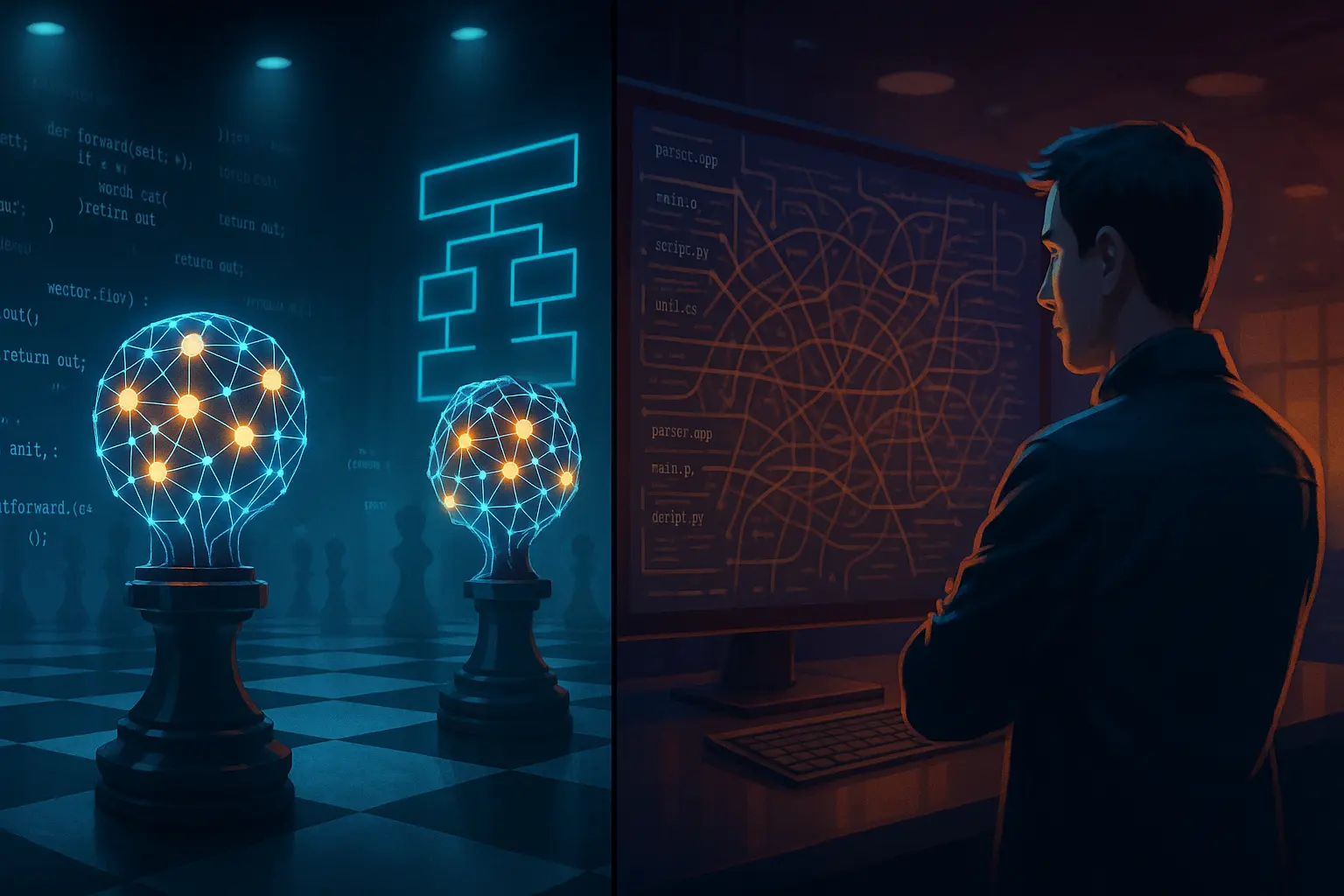The hype around AI code generation has reached fever pitch. We’ve watched models fix bugs, write functions, and ace isolated coding tests with impressive accuracy. But here’s the uncomfortable truth: passing individual tests doesn’t make you a real software engineer.
Researchers from Stanford, Princeton, and Cornell just dropped a reality check. They created CodeClash, a benchmark that throws AI models into multi-round programming tournaments where they must pursue high-level business goals—maximizing scores, acquiring resources, staying alive—by iteratively building and refining a codebase. This isn’t about solving a single problem; it’s about strategic, long-term software development.
After running 1,680 tournaments, the results are in. And they’re humbling for anyone betting on autonomous AI developers. Here are five critical findings that reveal where today’s most advanced models fall dangerously short.
1. Human Expert Delivers Absolute Domination
Let’s start with the most striking result. Researchers matched the tournament’s top-performing AI—Claude Sonnet 4.5—against gigachad, a static bot coded by an expert human programmer. The human’s code remained unchanged throughout all rounds.
The outcome? A complete shutout.
Claude Sonnet 4.5 failed to win even once across 150 head-to-head rounds. When researchers ran the full simulation dataset—37,500 individual game simulations—the AI’s win count remained stuck at zero.
This isn’t a close race. It’s a massacre that exposes the vast chasm between completing isolated coding tasks and executing sustained strategic reasoning. In competitive, complex environments, skilled human developers still reign supreme. True engineering demands far more than generating syntactically correct code on demand.
2. Losing Streak? AI Just Gives Up
CodeClash uncovered a critical weakness: AI models can’t recover from failure. When their strategy starts failing, they rarely pivot effectively to find a winning path.
The numbers tell a brutal story:
| Consecutive Losses | Claude Sonnet 4.5 Comeback Rate | Other Models Comeback Rate |
|---|---|---|
| 1 round | < 33% | Lower |
| 5 rounds | < 15% | < 10% |
After just one loss, Claude Sonnet 4.5’s probability of winning the next round plummets below one-third. Five consecutive defeats? Comeback rates crater below 15% for the leading model and below 10% for all others.
The researchers’ conclusion is damning: “This suggests an inability of models to reconsider strategies, or adapt to opponents or the arena state.”
In real-world software development, diagnosing failing approaches, learning from mistakes, and pivoting strategies is essential. Today’s AI coders demonstrably lack this resilience—a potentially devastating flaw for any iterative development workflow.
3. Codebases Descend Into Chaos
As tournaments progress, AI-managed repositories become increasingly disorganized. Instead of refining existing code when strategies fail, models abandon ship and create new files at a nearly linear rate, desperately hunting for something that works.
Claude Sonnet 4.5 generated over 30 new files on average during a single tournament—a brute-force approach that produces catastrophic results:
- Throwaway files everywhere: Scripts written for one specific analysis, used once, then forgotten
- Filename redundancy nightmare:
analyze_round_13_v2.pybecomes the norm - Zero code consolidation: No cleanup, no refactoring, just accumulation
In enterprise environments, this behavior directly translates to:
- Mounting technical debt
- Security vulnerabilities hiding in abandoned code
- Exploding maintenance costs
- Questionable economic viability for long-term projects
4. Hallucinations Drive Code Changes
Perhaps the most alarming discovery: AI models frequently change code based on hallucinated failure analysis.
Most models struggle to extract meaningful insights from competition logs. The result? Code edits “ungrounded” in actual evidence of what went wrong.
| Model | Average Unsubstantiated Claims | BattleSnake Arena |
|---|---|---|
| Claude Sonnet 4.5 | > 17% of rounds | 46% of rounds |
| Other models | Higher rates | Even worse |
Claude Sonnet 4.5 makes uncorroborated claims about failure causes in over 17% of rounds—and in certain arenas like BattleSnake, this spikes to a staggering 46% of rounds.
Even worse? Models deploy these hallucination-based changes without running tests or simulations to validate whether they actually improve performance. This isn’t just poor practice—it’s a recipe for production disasters. Without rigorous analysis-change-validate loops, autonomous agents become high-speed bug generators rather than reliable developers.
5. No Single Model Dominates
The tournament revealed an inconvenient truth: there is no “best” AI coder. Different challenges expose different weaknesses.
Claude Sonnet 4.5, the overall top performer, finished only fourth in the Poker arena. Researchers identified distinct development styles—some models like o3 were minimalists editing few files, while others like Claude Sonnet 4.5 were high-activity editors.
Critically, no correlation exists between activity level and win rate. Even more surprising: when AIs could see opponent code, this intelligence advantage didn’t automatically translate to better performance.
The takeaway? The path forward isn’t finding one superior model with the “correct” style. The real challenge is addressing fundamental strategic limitations—poor log analysis, failure adaptation, long-term planning—that plague all current models regardless of their approach.
What This Means for Autonomous Development
CodeClash makes one thing crystal clear: while large language models excel at narrow, well-defined coding tasks, they haven’t mastered the strategic, adaptive, long-term thinking that defines real software engineering.
The benchmark identifies specific hurdles that must be overcome:
- Improving strategic reasoning capabilities
- Building resilience to recover from failures
- Instilling discipline for sustainable codebase maintenance
The critical question isn’t whether these models can write code—they can. It’s whether the fundamental flaws in reasoning, adaptability, and strategic thinking are architectural limitations or merely engineering challenges waiting to be solved by the next generation.
For now, the gap between AI coding assistants and autonomous software engineers remains wide. CodeClash has given us a clear roadmap of exactly where that gap exists—and how far we still have to go.
Research Source: CodeClash benchmark study conducted by researchers from Stanford University, Princeton University, and Cornell University
Methodology: 1,680 multi-round programming tournaments across six competitive arenas (including RobotRumble, BattleSnake, and Poker), featuring top AI coding models including Claude Sonnet 4.5, o3, and others competing against each other and human-written code.
Source: Official Link
